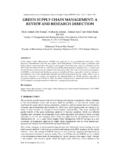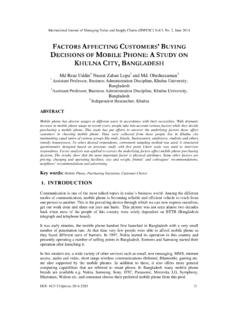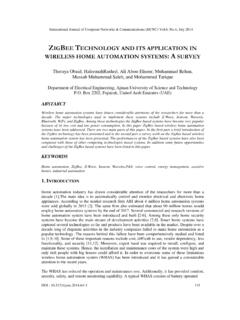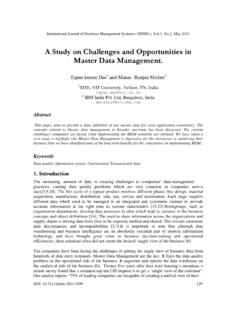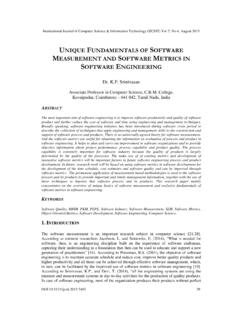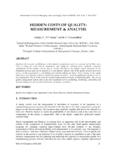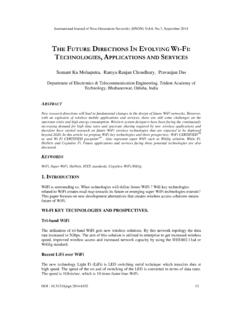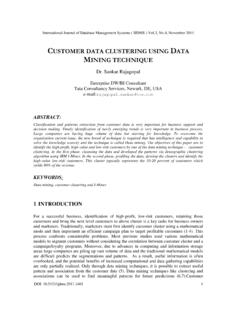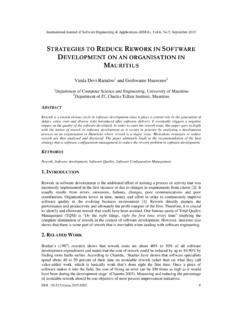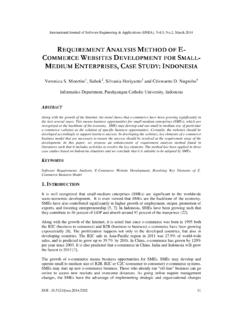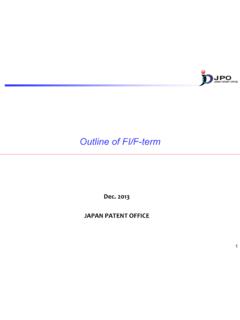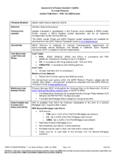Transcription of SINR, RSRP, RSSI AND RSRQ MEASUREMENTS IN …
1 International Journal of Wireless & Mobile Networks (IJWMN) Vol. 7, No. 4, August 2015 DOI : 113 SINR, rsrp , rssi AND rsrq MEASUREMENTS IN LONG TERM EVOLUTION NETWORKS 1 Farhana Afroz, 1 Ramprasad Subramanian, 1 Roshanak Heidary, 1 Kumbesan Sandrasegaran and 2 Solaiman Ahmed 1 Faculty of Engineering and Information Technology, University of Technology, Sydney, Australia 2 Department of Electrical and Electronic Engineering, University of Dhaka, Bangladesh ABSTRACT The four basic Radio Resource Management (RRM) MEASUREMENTS in Long Term Evolution (LTE) system are Channel Quality Indicator (CQI), Reference Signal Received Power ( rsrp ), Reference Signal Received Quality ( rsrq ), and Carrier Received Signal Strength Indicator ( rssi ). A measurement of channel quality represented by Signal to Interference plus Noise Ratio (SINR) is used for link adaptation along with packet scheduling, whereas rsrp and rsrq are needed for making handover decision during intra-eUTRAN (evolved Universal Terrestrial Random Access Network) handover in LTE.
2 In this paper, some practical measurement results recorded from a live LTE network of Australia using a commercial measurement tool namely NEMO Handy are analysed to verify the possible relationships among SINR, rsrp , rssi and rsrq as well as to evaluate the effects of SNR on throughput. In addition, the intra-eUTRAN handover events occurred during the test period within the test area are studied. The analysis yields some useful information such as: if the SINR is good for a measurement slot, higher throughput is achieved; rsrp and SNR are proportional to each other on average; and lesser is the difference between rssi and rsrp , better is the rsrq each of which is consistent with theory. All the measurement results are evaluated using computer programs built on MATLAB platform. KEYWORDS RRM, SINR, rsrp , rssi , rsrq , Link Adaptation, Packet Scheduling, Throughput, Handover In recent years, the demand of accessing high data rate applications on mobile device has noticeably increased.
3 LTE, commonly marketed as 4G, is the 3 GPP-standardized OFDMA/SC-FDMA (Orthogonal Frequency Division Multiple Access in downlink/ Single Carrier Frequency Division Multiple Access in uplink) based wireless cellular system, which mainly focuses on providing high peak data rates, high spectral efficiency, improved capacity and coverage, short round trip time, and spectrum flexibility [1, 2, 3]. LTE radio access network, usually termed as e-UTRAN, consists of eNodeBs only where all RRM-related functions are performed. RRM ensures that the air interface resources are efficiently utilized so that network efficiency is maximised, Quality of Service (QoS) required for each service/bearer/user be guaranteed, and high capacity and planned coverage are maintained. The RRM functionalities comprise of a range of algorithms employed for the optimal utilisation of radio resources.
4 LTE RRM functions can be categorized as network based functions and connection based functions [4]. The network based International Journal of Wireless & Mobile Networks (IJWMN) Vol. 7, No. 4, August 2015 114 RRM functions, which are performed for a whole cell, include packet scheduling, admission control and load control, whereas the connection based functions such as power control and handover control are executed per connection basis. Among these RRM functions, packet scheduling is the process by which available radio resources are allocated among active users in order to satisfy their QoS requirements [5]. The smallest unit of radio resource that can be allocated to a user for data transmission is called Physical Resource Blocks (PRBs). The main objectives of packet scheduling are to maximize the cell capacity, to satisfy the minimum QoS needed for connections, and to maintain adequate resources for best-effort users with no strict QoS requirements [6].
5 In channel dependent scheduling, scheduling decisions are made based on channel conditions. The basic principle of channel dependent scheduling is to allocate PRBs to the users with relatively better channel conditions, and to avoid PRB allocation to the users experiencing deep fades. All users need to report the CQI computed by decoding the reference signals to the eNodeB which selects the user for data transmission and determines MCS (Modulation and Coding Scheme) based on instantaneous channel quality. CQI is a quantized and scaled version of the experienced SINR. The process of adapting MCS depending on current channel conditions is termed as Link Adaptation. If the SINR is good, higher order MCS ( 64 QAM) can be selected implying that more bits per modulation symbol can be transmitted and higher throughput can be achieved.
6 If the SINR is poor, lower order MCS ( QPSK) should be selected implying fewer bits per symbol are transmitted which in turn results in lower throughput. Other important RRM function is making handover (HO) decision based on handover algorithms. LTE supports break-before-make HO or hard HO only. In general, LTE HO process is divided into three steps such as measurement , judgement, and execution among which measurement is a crucial step that can directly affect HO performance [7]. Two measurement criteria such as rsrp and rsrq are used to make a cell reselection or HO decision. When the rsrp and/or rsrq of the serving cell fall(s) below the rsrp and/or rsrq of the neighbor cell by a predefined HO margin for certain period of time, handover occurs. Fig. 1 shows that when a rsrp of a neighbor cell exceeds the signal strength of a serving cell by a predefined HO margin for certain duration, handover triggers.
7 This paper provides an experimental study on the LTE MEASUREMENTS such as SINR, rsrp , rssi and rsrq to find the possible relationships among them as well as to analyse the effects of SNR on throughput. Furthermore, the intra-eUTRAN handover events occurred during the test period within the test area are studied. Some practical measurement results recorded from a live LTE network of Australia using a commercial measurement tool namely NEMO Handy are analysed for these purposes. The rest of this paper is organized as follows. Section 2 illustrates an overview of each of these four LTE MEASUREMENTS followed by the obtained results and discussion in Section 3. Finally, Section 4 concludes the paper. Figure 1: A typical handover scenario [8] International Journal of Wireless & Mobile Networks (IJWMN) Vol. 7, No. 4, August 2015 115 OF LTE MEASUREMENTS In this section, the UE-related MEASUREMENTS in LTE such as SINR, rsrp , rssi and rsrq are illustrated as follows.
8 Signal to Interference plus Noise Ratio (SINR) is measured by UE on Resource Block (RB) basis. UE computes SINR on each RB, converts it to CQI and reports it to eNodeB where it is used to select the most suitable MCS for user data transmission in particular RB. SINR value defines the MCS to be used for a RB the number of bits per modulation symbol to be sent throughput to be achieved for that particular RB as well as the number of RBs to be allocated by eNodeB to user [9]. SINR can be defined as the ratio of the signal power to the summation of the average interference power from the other cells and the background noise. Reference Signal Received Power ( rsrp ) is a cell-specific signal strength related metric that is used as an input for cell resection and handover decisions. For a particular cell, rsrp is defined as the average power (in Watts) of the Resource Elements (REs) that carry cell-specific Reference Signals (RSs) within the considered bandwidth [10].
9 rsrp measurement , normally expressed in dBm, is utilized mainly to make ranking among different candidate cells in accordance with their signal strength. Generally, the reference signals on the first antenna port are used to determine rsrp , however, the reference signals sent on the second port can also be used in addition to the RSs on the first port if UE can detect that they are being transmitted [10, 11]. Reference Signal Received Quality ( rsrq ) measurement is a cell-specific signal quality metric. Similar to the rsrp measurement , this metric is used mainly to provide ranking among different candidate cells in accordance with their signal quality. This metric can be employed as an input in making cell reselection and handover decisions in scenarios (for example) in which the rsrp MEASUREMENTS are not sufficient to make reliable cell-reselection/handover decisions.
10 It is defined as [10]: =( . )( ) (1) where, N is the number of Resource Blocks (RBs) of the LTE carrier Received Signal Strength Indicator ( rssi ) measurement bandwidth. Received Signal Strength Indicator ( rssi ) is the linear average of the total received power observed only in OFDM symbols carrying reference symbols by UE from all sources, including co-channel non-serving and serving cells, adjacent channel interference and thermal noise, within the measurement bandwidth over N RBs [10, 11]. rssi is used as an input to compute the LTE rsrq measurement discussed above. From the above Eq. (1), it is seen that due to the inclusion of rssi , rsrq considers the combined effect of signal strength and interference.
